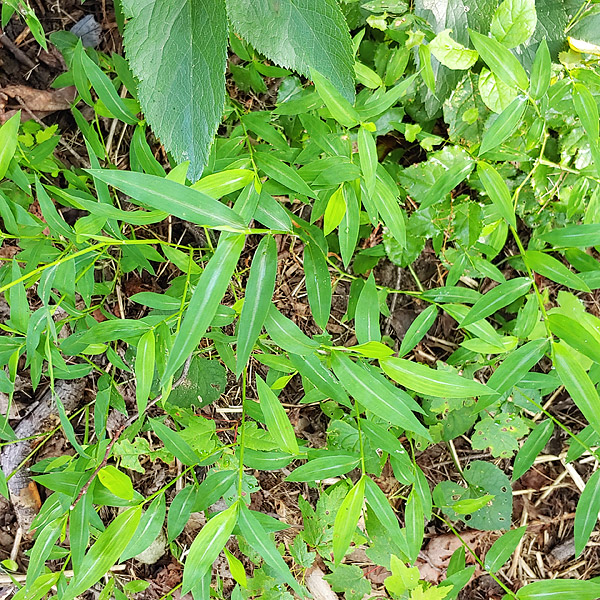
Japanese stiltgrass (Microstegium vimineum) is a non-native, invasive, annual grass. It has lance like leaves with a silvery stripe down the center, arranged alternately on a thin, wiry stem somewhat like a very miniature bamboo. It normally is 2-3 feet tall at maturity in late summer with seed heads at the top of each stem.
Stiltgrass was probably introduced into this country as packing material in shipments of goods from China in the early 1900’s. Since then it has made itself at home in open woodlands, paths, roadsides and of course lawns and flowerbeds.
Stiltgrass has the ability to form dense stands that crowd out and smother native and desired plants. The stems root at the nodes, allowing a single plant to advance across the ground. While stiltgrass is an annual and the parent plant dies in winter, it creates an enormous amount of seed and quickly builds up a bank of seeds in the soil. Each plant can produce up to 1000 seeds and they remain viable in the soil up to 5 years. The key to control is preventing new seed production and preventing germination of the existing bank of seeds.

The plants are shallow rooted and can be pulled by hand. Plants should be removed before mid-August when the seed matures. Cutting or breaking the plant stems earlier in the season may stimulate them to create and drop seed early, so try to remove each plant completely. The process of weeding may disturb soil and expose more seeds from the seed bank, encouraging new weeds. Mulching directly after weeding will help prevent germination of new seeds. Planting desirable plants densely to leave less open garden area may also help prevent stiltgrass germination.
Plants in a mowed lawn will still create seeds at the lower height. If possible, wait until just before the seed matures to cut large stands of stiltgrass so there is not enough time before winter cold for seed development.
There are some options for chemical control of stiltgrass. This article from Penn State Extension describes those options.
Want a little more information? Here are some links:
Penn State Extension – Controlling Japanese Stiltgrass in Your Garden
PA Dept. of Conservation and Natural Resources: Japanese Stilt Grass PDF

